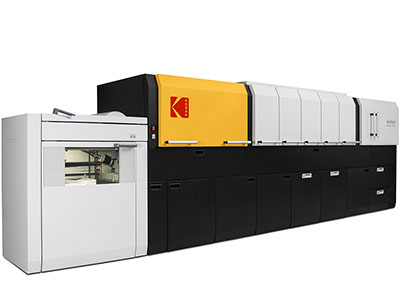The Nexfinity can be upgraded to support dimensional print, coatings, gamut expansion and security elements, all at production speeds
Kodak has announced an addition to its Nexpress digital sheet-fed press line, the Nexfinity, which it says offers offset quality, improved performance and reduced running costs.
Available this spring, the Nexfinity will cost US $885,000 but according to product manager Len Christopher, will offer running costs around two-thirds those of current Nexpress models. This is thanks to extended life of imaging and blanket cylinders, yielding per-page costs of around 1.5 Euro cents, dependent on print volumes. A typical monthly production cycle would be around 4 million sheets.
Dynamic Imaging Technology analyses page content and adjusts printing according to the content type so that type and line art are sharp while skin tones or skies are subtly graduated. This is enabled both through embedded software in the UK co-developed 1200dpi printheads and by a new LED writing engine that supports 256 greyscales per process colour rather than the more usual binary on/off options. This is complemented by the ability to control the order in which inks are laid down during printing so that optional white ink can be laid under process colours, for example. The existing set of Nexpress options for speciality inks is supported, including a new translucent silver metallic.
The new press offers long-sheet support up to 1200mm – which suits retail shelf applications – and handles stock up to 24pt (around 400gsm) at production rates from 83 to (by later in the year) 152ppm, dependent on sheet size and weight. Kodak says the press is suitable for a wide range of tasks from direct mail and commercial print to publishing and packaging.
Speaking to Digital Printer, Mr Christopher said that Kodak is targeting litho replacement work in larger commercial sites where the fast setup and collated output from a digital press contribute most significantly to short-run production times, while longer intervals between component replacement or maintenance help productivity for longer runs. He also said that customers of Kodak’s legacy photo business should find the machine attractive for its quality and (in the long sheet version) ability to print landscape format lay-flat photo books.
To complement the press, Kodak has also developed new workflow automation in the form of a Multi-Press Station that allows an operator to manage work on up to four Nexfinity (or Nexpress) presses from one location plus a Productivity Cart to store and manage cleaning of swappable parts. A new APPE-based DFE comes with the press, which includes a comprehensive standalone prepress toolkit but also supports integration via JDF/JMF with Kodak’s Prinergy or third-party workflow offerings.

